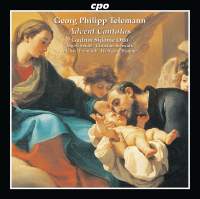Texte paru dans: / Appeared in: |
|
|
Outil de traduction ~ (Très approximatif) |
|
|
Reviewer: Bertil
van Boer I usually associate the cantatas of Georg Philipp Telemann with joyous and powerful works that challenge both voices and orchestras with their full-bodied sound. One often forgets that he published his Harmonische Gottesdienst in an attempt to provide music that could be used by the more plebian forces one might find in various smaller churches throughout the Lutheran regions. Ancillary to this was another publication from about the same time, 1726–27, in which the composer released a series of intimate works for voice and continuo entitled Auszug derjenigen musicalischen und auf die gewöhnlichen Evangelien gerichteten Arien (and this is the short title). These were works that were performed during that year in the Hamburg churches to texts by Johann Friedrich Helbig from Eisenach, a friend whom Telemann had known for a number of years.
It is clear that the composer
was mainly interested in the marketing potential of these works, but this
did not diminish his attempt to imbue them with his own particularly
inventive musicality. Each is quite different from each other, a testament
to his inventive musical genius. This disc takes a portion of this edition
meant mainly for Advent (a second disc with others of the same ilk is
mentioned in the excellent notes as being in process). The voice types are
soprano and bass/baritone, and the continuo is unspecified, but here the
compiler Gudrun Otto has chosen a variety that includes the lute, theorbo,
cello, and keyboard (mostly harpsichord, but also the occasional organ as
well). Telemann himself noted that the arias that comprise these “cantatas”
were originally set more fully, but in the interests of brevity and
compactness, he opted to revise the continuo line to compensate for removing
the larger instrumentation. The result here is a set of intimate and often
poignant works. Several examples will demonstrate the effectiveness of Telemann’s vision. In the cantata for the second Sunday of Advent, the opening word “Heul” is practically howled instead of sung at the beginning without instrumental preparation. The aria accompaniment is limited to a cembalo and theorbo, allowing the gnarly vocal line and expostulations to come out. The use of close cadential harmonies emphasizes the admonitory nature, and also brings out a nice contrast with the more fluid continuo aria of the second aria “Ich freue mich auf jenen Tag.” The single aria meant for the third Sunday has a swooping line to the words “Erwecke dich,” a lively wake-up call that moves into the higher soprano register. In the opening aria of the cantata for the first day of the Christmas celebration, the continuo cello line is quite virtuoso, leaving the voice to accompany it with a lilting and dance-derived tune. The second aria, also for soprano, has the cello line continuo roll in triplets, but this time the voice has its own dominant role, with a meandering melody that rolls right along. These are, as one might expect, carefully crafted compositions, with enough vocal virtuosity to entice singers but musically dramatic as well.
The
baritone of Ingolf Seidel reflects a good knowledge of this Baroque cantata
style. He is flexible, resonant, and right in tune. Gudrun Otto’s soprano
can be a bit screechy at times, especially in the upper registers, but she
does have a nice sense of phrasing and pitch. The continuo work is solid and
stable, even in the rather complex bass lines that Telemann makes them do.
There is some occasional muddiness in the cello, such as the aria “Mächtige
Heiland,” but for the most part Christine Schwark handles the sometimes
virtuoso parts with technical ease. As with most of CPO’s offerings on
Telemann, the sound quality is excellent. This is to be welcomed as a fine
addition to the growing repertory of his works available on disc.
| |
|
Support us financially by purchasing this disc from eiher one of these suppliers. Un achat via l'un ou l'autre des fournisseurs proposés contribue à défrayer les coûts d'exploitation de ce site. |
|
|
|
|
|
Cliquez l'un ou l'autre
bouton pour découvrir bien d'autres critiques de CD |
|




